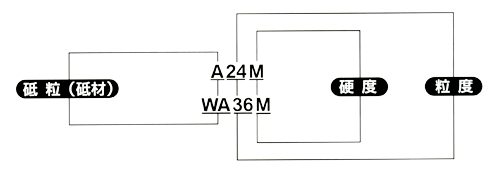Abrasive grains
As a cutting edge, it plays an important role in grinding workpieces.
| A abrasive grain |
Titania (TiO) contained in general abrasive grains2), It turns brown and changes to black, blue-gray, and yellow by firing at high temperature. The most balanced grade of grinding wheel life and grinding performance. Used for general steel materials. |
| WA abrasive grains |
It looks transparent and white because High-purity alumina (AI2O3 98% or more). The life of the grinding wheel is inferior to that of A-abrasive grains, but its hardness is high and it is highly crushable, so it is suitable for precision grinding. Used for hardened steel, light grinding, and precision grinding. |
| C abrasive grain |
There are two types of abrasives made of carbon silicon (SiC), black (C) and green (GC).
Its hardness is higher than that of alumina, but its toughness is low, and its heat resistance is extremely high in a non-oxidizing atmosphere. It is used for grinding and polishing cast iron, non-ferrous metals, and non-metal materials.
|
| GC abrasive grains |
Silicon Carbide Abrasive (SiC) that exhibits a green color.
It is used for grinding cast iron and non-metal materials because it has a slightly higher hardness and higher crushability than black ones.
|
| Z abrasive grain |
By adding alkali to an aqueous solution of zirconium acetate and heat-treating it, Zirconia (ZrO2) is obtained. It is extremely tough and has excellent wear resistance. Widely used for polishing high tensile strength materials such as high carbon steel and alloy steel stainless steel. |
granularity
It is represented by # (number), and the closer the number is to 1, the larger the particle size (coarse grain), and the larger the number, the smaller the particle size (fine grain).

Hardness (coupling degree)
It indicates the strength of the binder that holds the abrasive grains.
Generally referred to as "hardness", it is not the hardness of the abrasive grains or the strength of the grinding wheel, but the softness and hardness of the grinding action.

Display details








